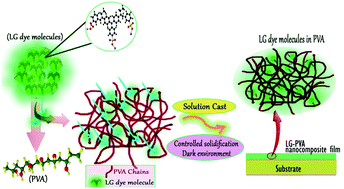Organic dye impregnated poly(vinyl alcohol) nanocomposite as an efficient optical limiter: structure, morphology and photophysical properties
Abstract
A new

* Corresponding authors
a
Department of Physics, University of Kerala, Kariavattom, Thiruvananthapuram-695581, Kerala, India
E-mail:
sreejasreedhar83@gmail.com, drcimuneera@gmail.com
Fax: +91-471-2305632
Tel: +91-471-2308920
b School of Chemical Sciences, M. G. University, Kottayam, Kerala-686560, India
c Light & Matter Physics Group, Raman Research Institute, Sadashivanagar, Bangalore-560080, India
A new

 Please wait while we load your content...
Something went wrong. Try again?
Please wait while we load your content...
Something went wrong. Try again?
S. Sreeja, S. Sreedhanya, N. Smijesh, R. Philip and C. I. Muneera, J. Mater. Chem. C, 2013, 1, 3851 DOI: 10.1039/C3TC30427B
To request permission to reproduce material from this article, please go to the Copyright Clearance Center request page.
If you are an author contributing to an RSC publication, you do not need to request permission provided correct acknowledgement is given.
If you are the author of this article, you do not need to request permission to reproduce figures and diagrams provided correct acknowledgement is given. If you want to reproduce the whole article in a third-party publication (excluding your thesis/dissertation for which permission is not required) please go to the Copyright Clearance Center request page.
Read more about how to correctly acknowledge RSC content.
 Fetching data from CrossRef.
Fetching data from CrossRef.
This may take some time to load.
Loading related content
